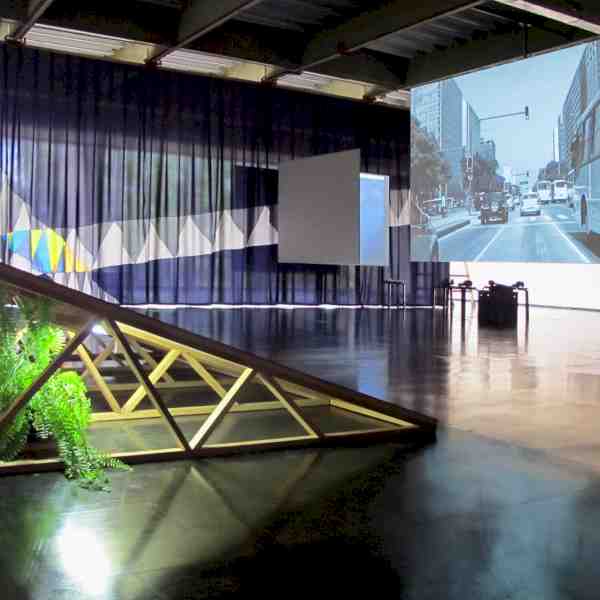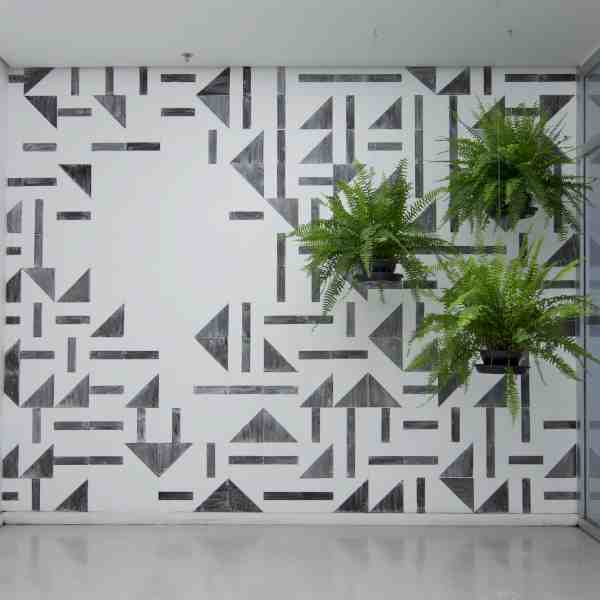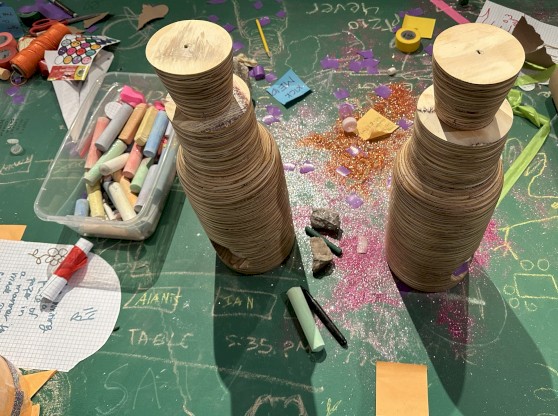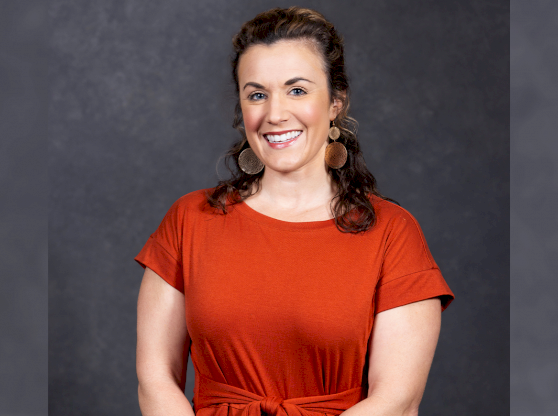- Date & Time
Thursday, September 05, 2024 — through
Friday, November 01, 2024Detours and Memories exhibition dates
- Thursday, September 05, 2024
5:00pm
Opening Reception for Detours and Memories
2024-09-05 05:00:00 pm1969-12-31 07:00:00 pmAmerica/New_YorkOf Memories & Detours: Laercio Redondo and Birger LipinskiGary R. Libby University Gallery, Gary R. Libby Focus Gallery, & Grinter Gallery Friday, September 13, 2024 — through
Friday, November 01, 2024Displays (for Detours & Memories) exhibition dates
- Cost
- Free
- Description
As an exhibition, Of Memories & Detours: Laercio Redondo and Birger Lipinski comprises three installations, one in each of the University Galleries. The main space presents Detour (2015); the Gary R. Libby Focus Gallery showcases Restoration (2012, from the series Memory from Brasília); and the Grinter Gallery hosts the new site-specific commission Displays (for Memories & Detours) (2024). Taken together, what these works demonstrate is how Laercio Redondo and Birger Lipinski superimpose various grids of meaning to interrogate official histories and question the particular exclusions and naturalized assumptions by which they often proceed. In so doing, the artists implore us to read past and present representations through past and present histories, creating a space for the viewer to assess the complexity of historical memory and its ambiguities from different perspectives and material supports, including a filmed movie, designed curtains and decorative murals, live plants, and the pages of books.
First presented in Redondo’s mid-career retrospective at the Museu de Arte Moderna do Rio de Janeiro (MAM-RJ), Detour focuses on Lota de Macedo Soares, a self-taught architect and landscape designer, and aims, albeit ever so discretely, to bring attention to her pioneering role in the construction of Parque do Flamengo (Flamengo Park). The park is a massive recreational area for the city of Rio de Janeiro, which was inaugurated in 1965 and is usually exclusively referenced in relation to Roberto Burle Marx’s landscape project for the site. Redondo redresses the historical oversight not via direct reference, but in the film installation that takes us from MAM-RJ’s public building to the Casa Samambaia (Fern Residence), the private home in Petrópolis where Lota lived with her partner, the American poet Elizabeth Bishop. The film alternates between extended travelling shots of this route with blank screens and a voiceover that evokes a range of affective and cultural values associated with the private and the public. In so doing, it presents a spatial and historical detour: it begins and ends with Lota’s contributions to public and private architectural projects and through the soundtrack calls upon visitors to reflect upon the possible motives for Lota’s absence from Brazilian collective memory.
Detour’s original institutional frame (MAM-RJ), works in tandem and in tension with the work’s evocation of memory, given that the museum is sited in the very park for which Lota had relentlessly labored. Yet by travelling to a private dwelling in Petrópolis, Detour also obliquely introduces the question of the love and intimacy of its residents: an international lesbian couple at mid-century in Rio de Janeiro. This said, love and intimacy—as they are conventionally packaged and deployed—is nowhere visible or apparent in Redondo’s film or in its installation, which was designed in collaboration with Lipinski and combines fabric curtains, a screen and a viewing platform with ferns nestled below. Owing to the rituals of their watering, the ferns make visible the acts of care that go into cultural production, while the handcrafted curtains recall the structure of the couple’s Petrópolis home. Through a calculated economy of representation, Redondo’s and Lipinski’s work activates a thoughtful assessment of the history of architecture and urban planning, but also of the personal intimacies of which such histories, in part, could be made and (re)written. Such intimacies come together, one might say, in the film’s alternative route.
Credit:
text is an excerpt adapted from Kaira M. Cabañas, “Intimacies,” in Laercio Redondo: Intimacies / Proximidades (Rio de Janeiro: Museu de Arte Moderno do Rio de Janeiro; Berlin: The Green Box, 2016).
Of Memories & Detours: Laercio Redondo and Birger Lipinski
is sponsored by University Galleries and the School of Art + Art History (SA+AH), University of Florida, Gainesville.
Parallel exhibitions:
Restoration, from the series Memory from Brasília, Gary R. Libby Focus Gallery, September 5–November 1, 2024.
Curated by Damon Reed
Displays (for Memories & Detours), Grinter Gallery, September 13–October 18, 2024.
Curated by Valerie Luciow
More Information on:
Restoration, from the series Memory from Brasília
Gary R. Libby Focus Gallery
In their installation Restoration, Laercio Redondo and Birger Lipinski explore themes of memory, erasure, and utopian visions of modernist Brazil. The work, which is part of the series Memory from Brasília, was first exhibited in 2012 and draws inspiration from the iconic murals of Athos Bulcão (1918–2008). Bulcão was the architect responsible for the elaborate, geometric tile work that adorns many of Brasília’s buildings, and his style became a point of reference for Redondo and Lipinski as they (re)imagined the cityscape.
Restoration pays homage to Bulcão’s legacy by using the geometry of his tiles to challenge the narrative of Brasília’s development as well as Brazil’s national identity more broadly. Key to understanding this work is that Bulcão allowed Brasília’s construction workers to install the tiles at their own discretion, whereby Bulcão’s mural aesthetic is imbued with the history of labor and migration to the capital city. Similarly, by having MFA students paint the gallery wall using stencils based on Bulcão’s geometry, the artists capture aspects of the labor and care that go into artistic production. In this way, Redondo and Lipinski cite the history of art by incorporating biographical elements and formal references to an artist’s work, which have often been marginalized and excluded from the dominant narratives of art and architectural history.
Hanging in front of the geometric patterned wall, ferns are suspended from the ceiling. The introduction of live plants into the gallery space serves a twofold purpose. First, the artists juxtapose the organic matter of the plants with the geometric rigidity of the abstract mural. Secondly, ferns serve a symbolic purpose and allude to the public gardens of Brasília created by landscape architect Roberto Burle Marx (1909–1994). Brasília’s urban design creates a rich dialogue between constructed and natural environments. Celebrated as the “Garden City,” Brasília is laden with gardens that feature tropical plants, such as ferns, that create vibrant compositions that punctuate public and private spaces. By injecting life into the gallery, Redondo and Lipinski underscore a history that is simultaneously alive and constructed, a product of both the past and the present that requires constant societal cultivation and attention.
Bulcão’s tiles as well as Redondo and Lipinski’s installation each highlight how the cityscape is a site of personal and collective memory. By evoking Bulcão’s aesthetic, Restoration becomes a space of both remembrance and resistance. The installation invites viewers to consider how Brasília’s modernist ideals intersect with the diverse lives of the residents inhabiting the city and the laborers that constructed it, revealing rich narratives that form the heart of the collective consciousness.
-Damon Reed, Ph.D. student in Art History
Of Memories & Detours: Laercio Redondo and Birger Lipinski is an exhibition that resulted from the Curatorial Studies Seminar, a collaboration between University Galleries and the School of Art + Art History at the University of Florida. In addition to Restoration, the exhibition includes Detour, on view at the Gary R. Libby University Gallery (September 5– November 1, 2024), and Displays (for Memories and Detours) on view at the Constance and Linton Grinter Gallery (September 13–October 18, 2024).
Exhibition-related Programming
To Be Announced
Parking Information
Daytime Parking
There are 3 reserved gallery parking spots located in the lot just east of Reid Hall. From SW 13th Street, enter campus via Museum Road, then take the first right into the Orange decal parking lot and follow the lot until it dead-ends. The gallery spots can be found on the right, facing SW 13th Street. A temporary (one-day) parking pass can be retrieved from the Gary R. Libby University Gallery. Parking restrictions for this lot are lifted at 4:30pm.
Reception Parking
The closest parking to the Gary R. Libby University Gallery is the lot behind (to the west of) Tigert Hall. From University Avenue, enter campus via Buckman Drive and turn left onto Union Road. Follow Union Road through the 4-way stop. The parking lot entrance is on the right just past Walker Hall. Parking restrictions for this lot are lifted at 5:30pm.
Parking permits are issued to gallery visitors in the University Gallery. - Links
- VenueGary R. Libby University Gallery, Gary R. Libby Focus Gallery, & Grinter Gallery
- Address
Student Stories : Oct 13, 2025
+ More




